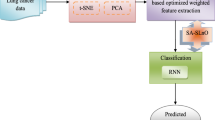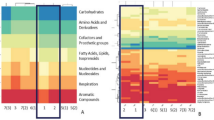Abstract
The current work aims to analyse the historical data pertaining to breast cancer to detect and predict the disease. For the same, authors employ t-distributed stochastic neighbor embedding (t-SNE), a well-established dimensionality reduction method. The authors also suggest implementing the snapshot ensembling technique to create an efficient model that potentially assists medical professionals in disease diagnosis. Employing t-SNE enables the generation of improved scatter plots in addition to cost optimization. Further, the current manuscript also uses a snapshot ensemble deep learning framework that integrates the predictions through various base models leading to accuracy enhancement. The proposed model is implemented on the Wisconsin Breast Cancer Dataset(WBCD) that is openly accessible at UCI Machine Repository. During the experimental evaluation, proposed model yields an accuracy of 86.6%,higher than the state-of-art models like averaging, weighted averaging, stacked ensemble, and Polyak Rupert that yield an accuracy of 81%, 81.7%, 84.7%, and 82.2% respectively and hence establishes the competence of proposed model. The obtained result is highly encouraging and resultantly opens the avenue for implementing the proposed model in real life at large.









Similar content being viewed by others
References
Abdar M, Makarenkov V (2019)CWV-BANN-SVM ensemble learning classifier for an accurate diagnosis of breast cancer. Measurement 146:557–570
Abdar M, Makarenkov V (2019)CWV-BANN-SVM ensemble learning classifier for an accurate diagnosis of breast cancer. Measurement. https://doi.org/10.1016/j.measurement.2019.05.022
Ahmad LG, Eshlaghy AT, Poorebrahimi A, Ebrahimi M, Razavi AR (2013) Using three machine learning techniques for predicting breast cancer recurrence. J Health Med Inform 4:124. https://doi.org/10.4172/2157-7420.1000124
Alam KMR, Siddique N, Adeli H (2020) A dynamic ensemble learning algorithm for neural networks. Neural Comput Appl 32(12):8675–8690. https://doi.org/10.1007/s00521-019-04359-7
Alam KM, Siddique N, Adeli H (2020) A dynamic ensemble learning algorithm for neural networks. Neural Comput Appl 8675–8690. https://doi.org/10.1007/s00521-019-04359-7
Ali A, Zhu Y, Zakarya M (2021) A data aggregation based approach to exploit dynamic spatio-temporal correlations for citywide crowd flows prediction in fog computing. Multimed Tools Appl 80:31401–31433. https://doi.org/10.1007/s11042-020-10486-4
Ali A, Zhu Y, Zakarya M (2021) Exploiting dynamic spatio-temporal correlations for citywide traffic flow prediction using attention based neural networks. Inform Sci 577:852–870
Ali A, Zhu Y, Zakarya M (2022) Exploiting dynamic spatio-temporal graph convolutional neural networks for citywide traffic flows prediction. Neural Netw 145:233–247
Ashiba HI (2020) A proposed framework for diagnosis and breast cancer detection. Multimed Tools Appl 10:1–37. https://doi.org/10.1007/s11042-020-10131-0
Bejnordi BE, Veta M, Van Diest PJ, Van Ginneken B, Karssemeijer N, Litjens G, Van Der Laak JA, Hermsen M, Manson QF, Balkenhol M, Geessink O (2017) Diagnostic assessment of deep learning algorithms for detection of lymph node metastases in women with breast cancer. JAMA 318(22):2199–210. https://doi.org/10.1001/jama.2017.14585
Bhattacharya S, Maddikunta PKR, Pham QV, Gadekallu TR, Chowdhary CL, Alazab M, Piran MJ (2021) Deep learning and medical image processing for coronavirus (COVID-19) pandemic: A survey. Sustain Cities Soc 65:102589. https://doi.org/10.1016/j.scs.2020.102589
Wolberg William H, Mangasarian O L (1990) Multisurface method of pattern separation for medical diagnosis applied to breast cytology. In: Proceedings of the National Academy of Sciences, U.S.A. 87:9193-9196
Bunte K, Haase S, Biehl M, Villmann T (2012) Stochastic neighbor embedding (SNE) for dimension reduction and visualization using arbitrary divergences. Neurocomputing 90:23–45. https://doi.org/10.1016/j.neucom.2012.02.034
Chaurasia V, Pal S, Tiwari BB (2018) Prediction of benign and malignant breast cancer using data mining techniques. J Algorithms Comput Technol 12(2):119–126
Fakoor R, Ladhak F, Nazi A, Huber M (2013) Using deep learning to enhance cancer diagnosis and classification. In: Proceedings of the international conference on machine learning. 28, 1–7
Gadekallu TR, Rajput DS, Reddy MPK, Lakshmanna K, Bhattacharya S, Singh S, … Alazab M (2020) A novel PCA–whaleoptimization-based deep neural network model for classification of tomato plant diseases using GPU. J Real-Time Image Process 1–14. https://doi.org/10.1007/s11554-020-00987-8
Gupta P, Garg S (2020) Breast cancer prediction using varying parameters of machine learning models. Procedia Comput Sci 171:593–601. https://doi.org/10.1016/j.procs.2020.04.064
Hakak S, Alazab M, Khan S, Gadekallu TR, Maddikunta PK, R, Khan WZ (2021) An ensemble machine learning approach through effective feature extraction to classify fake news. Futur Gener Comput Syst 117:47–58. https://doi.org/10.1016/j.future.2020.11.022
Hooda R, Mittal A, Sofat S (2019) Automated TB classification using ensemble of deep architectures. Multimed Tools Appl 78(22):31515–31532. https://doi.org/10.1007/s11042-019-07984-5
Howlader NN, Krapcho M, Miller D, Bishop K, Kosary CL, Yu M, Cronin KA (eds) (2019) SEER Cancer Statistics Review, 1975–2014, National Cancer Institute. Bethesda. https://seer.cancer.gov/csr/1975_2017. Assessed 13 Jul 2022
Huang G, Li Y, Pleiss G, Liu Z, Hopcroft JE, Weinberger KQ (2017) Snapshot ensembles: Train 1, get m for free. arXiv preprint arXiv:1704.00109
Jing W, Ma JT, Han CB (2020) Metastatic breast cancer coexisting with HER-2 amplification and EGFR exon 19 deletion benefits from EGFR-TKI therapy: A case report. Front Oncol 10:771. https://doi.org/10.3389/fonc.2020.00771
Kumar V, Mishra BK, Mazzara M, Thanh DN, Verma A (2020) Prediction of malignant and benign breast cancer: a data mining approach in healthcare applications. In: Advances in Data Science and Management Springer, Singapore, 435–442
Kumar V, Mishra BK, Mazzara M, Thanh DN, Verma A (2020) Prediction of malignant and benign breast cancer: a data mining approach in healthcare applications. In: Advances in Data Science and Management 435–442. Springer, Singapore. https://doi.org/10.1007/978-981-15-0978-0_43
Lee S, Amgad M, Masoud M, Subramanian R, Gutman D, Cooper L (2019) An ensemble-based active learning for breast cancer classification. In: 2019 IEEE International Conference on Bioinformatics and Biomedicine (BIBM). IEEE, 2549–2553
Li L, Pan X, Yang H, Liu Z, He Y, Li Z, Fan Y, Cao Z, Zhang L (2020)Multi-task deep learning for fine-grained classification and grading in breast cancer histopathological images. Multimed Tools Appl 79(21):14509–14528. https://doi.org/10.1007/s11042-018-6970-9
Loshchilov I, Hutter F (2016) Sgdr: Stochastic gradient descent with warm restarts. arXiv preprint arXiv:1608.03983
Mandal SK (2017) Performance analysis of data mining algorithms for breast cancer cell detection using Naïve Bayes, logistic regression and decision tree. Int J Comput Sci Eng 6(2):20388–20391
Mekha P, Teeyasuksaet N (2019) Deep learning algorithms for predicting breast cancer based on tumor cells. Joint International Conference on Digital Arts, Media and Technology with ECTI Northern Section Conference on Electrical, Electronics, Computer and Telecommunications Engineering (ECTI DAMT-NCON), 343–346
Nguyen QH, Do TT, Wang Y, Heng SS, Chen K, Ang WHM, Chua MC (2019) Breast cancer prediction using feature selection and ensemble voting. International Conference on System Science and Engineering ICSSE, 250–254
Osman AH, Aljahdali HMA (2020) An effective of ensemble boosting learning method for breast cancer virtual screening using neural network model. IEEE Access 8:39165–39174. https://doi.org/10.1109/ACCESS.2020.2976149
Salma MU (2015) BAT-ELM: a bio inspired model for prediction of breast cancer data. In: 2015 International Conference on Applied and Theoretical Computing and Communication Technology (iCATccT). IEEE, 501–506
Selvathi D, Aarthy Poornila A (2018) Deep learning techniques for breast cancer detection using medical image analysis. In: Hemanth J, Balas V (eds) Biologically rationalized computing techniques for image processing applications, vol 25. Springer, Cham. https://doi.org/10.1007/978-3-319-61316-1_8
Shen L, Margolies LR, Rothstein JH, Fluder E, McBride R, Sieh W (2019) Deep learning to improve breast cancer detection on screening mammography. Sci Rep 9(1):1–12. https://doi.org/10.1038/s41598-019-48995-4
Smith LN (2017) Cyclical learning rates for training neural networks. In: 2017 IEEE Winter Conference on Applications of Computer Vision (WACV), 464–472
Vasan D, Alazab M, Wassan S, Naeem H, Safaei B, Zheng Q (2020) IMCFN: Image-based malware classification using fine-tuned convolutional neural network architecture. Comput Netw 171:107138. https://doi.org/10.1016/j.comnet.2020.107138
Wang H, Yoon SW (2015) Breast cancer prediction using data mining method. In: IIE Annual Conference Proceedings. Institute of Industrial and Systems Engineers (IISE), p 818
Wang Q, Qin Z, Nie F, Yuan Y (2017) Convolutional 2D LDA for Nonlinear Dimensionality Reduction. IJCAI, 2929–2935
Wang Q, Qin Z, Nie F, Li X (2020) C2DNDA: A deep framework for nonlinear dimensionality reduction. IEEE Trans Ind Electron 68(2):1684–1694. https://doi.org/10.1109/TIE.2020.2969072
Wild CP, Weiderpass E, Stewart BW (2020) World cancer report: cancer research for cancer prevention. International Agency for Research on Cancer, Lyon
Yala A, Lehman C, Schuster T, Portnoi T, Barzilay R (2019) A deep learning mammography-based model for improved breast cancer risk prediction. Radiology 292(1):60–66. https://doi.org/10.1148/radiol.2019182716
Zheng J, Lin D, Gao Z, Wang S, He M, Fan J (2020) Deep learning assisted efficient AdaBoost algorithm for breast cancer detection and early diagnosis. IEEE Access 8:96946–96954. https://doi.org/10.1109/ACCESS.2020.2993536
Author information
Authors and Affiliations
Corresponding author
Additional information
Publisher’s Note
Springer Nature remains neutral with regard to jurisdictional claims in published maps and institutional affiliations.
Rights and permissions
About this article
Cite this article
Sharma, N., Sharma, K.P., Mangla, M. et al. Breast cancer classification using snapshot ensemble deep learning model and t-distributed stochastic neighbor embedding. Multimed Tools Appl 82, 4011–4029 (2023). https://doi.org/10.1007/s11042-022-13419-5
Received:
Revised:
Accepted:
Published:
Issue Date:
DOI: https://doi.org/10.1007/s11042-022-13419-5




